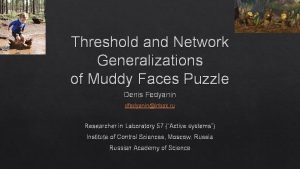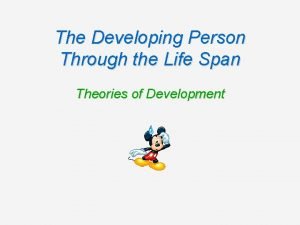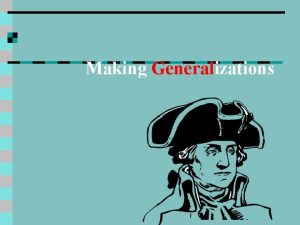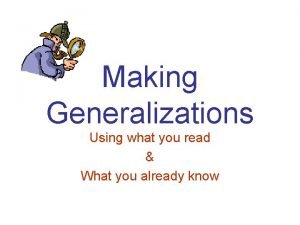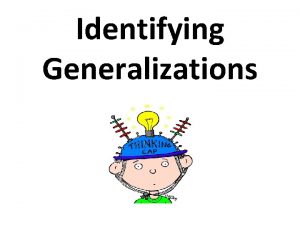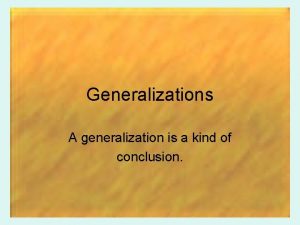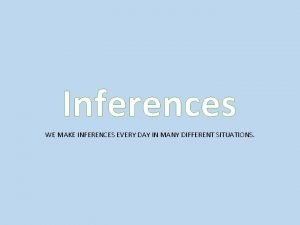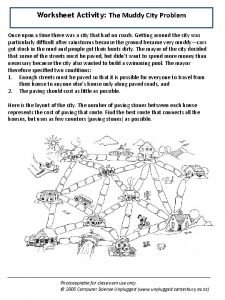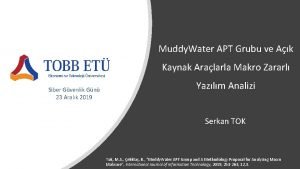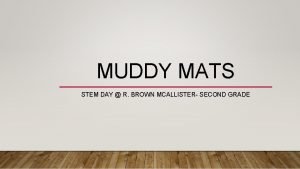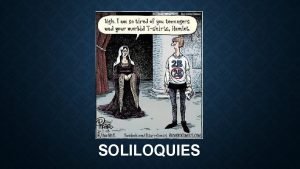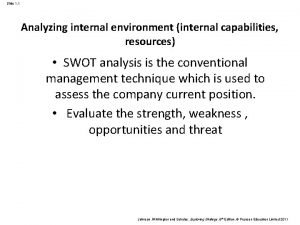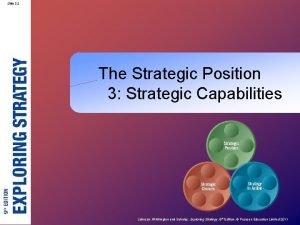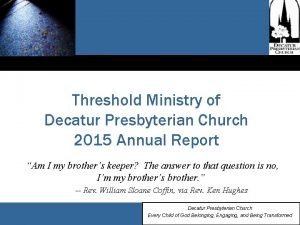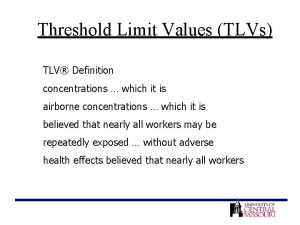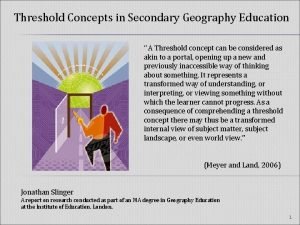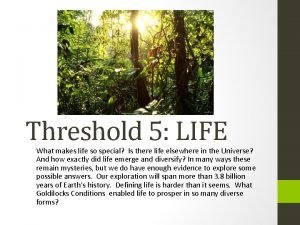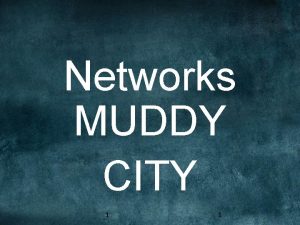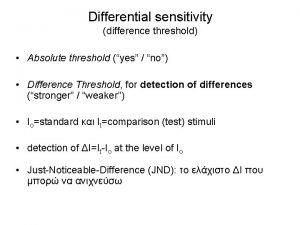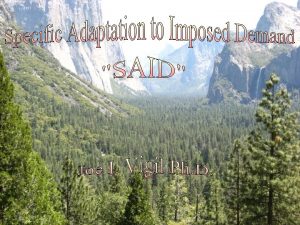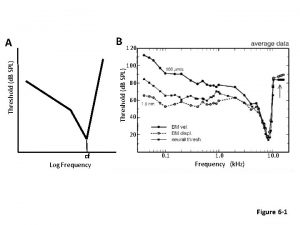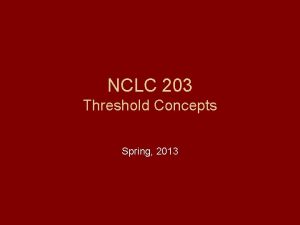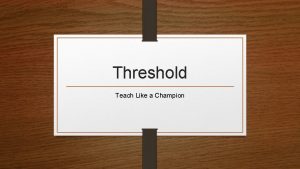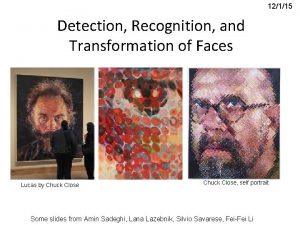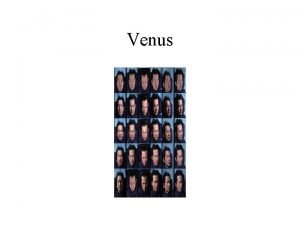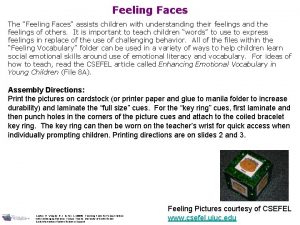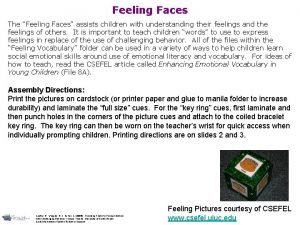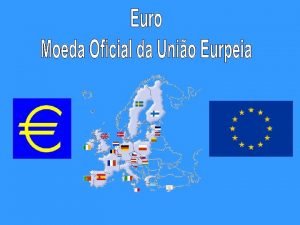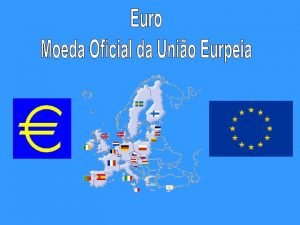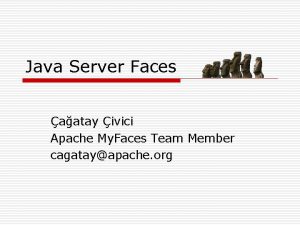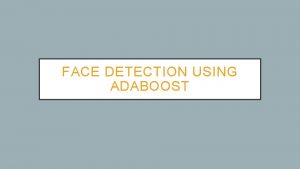Threshold and Network Generalizations of Muddy Faces Puzzle


























- Slides: 26

Threshold and Network Generalizations of Muddy Faces Puzzle Denis Fedyanin dfedyanin@inbox. ru Researcher in Laboratory 57 (“Active systems”) Institute of Control Sciences, Moscow, Russian Academy of Science

11 th IEEE International Conference on Application of Information and Communication Technologies 2017, Moscow, Russia 2

The basic story of the puzzle is as follows. Three children have muddy faces, and each can see the others’ faces, but not his own. A teacher announces to the children: "at least one of you has a muddy face". Then he asks: "Do you know whether your face is muddy or not? If so, raise your hand". No child raises a hand. Then, after some time, the teacher asks the same question, and again no child raises a hand. Some more time passes, and when asked the question a third time, each child raises his hand. 3

Littlewood (1953). A mathematician's miscellany. London: Meuthen. Lefebvre V. A. Conflicting Structures. – Moscow: Soviet Radio, 1973. – 158 p. (in Russian). The Structure of Awareness: Toward a Symbolic Language of Human Reflexion. – NY: Sage Publications, 1977. – 199 p. Granovetter, Mark, “Threshold Models of Collective Behavior, ” American Journal of Sociology, (1978), 83, 489– 515. 4

Hintikka J. , Reasoning about Knowledge in Philosophy: The Paradigm of Epistemic Logic. J. Symbolic Logic 53 (1988), no. 2, 663— 664 Aumann R. J. Interactive epistemology I: Knowledge// International Journal of Game Theory. August 1999, Volume 28, Issue 3, pp 263– 300 Lenzen, W. Recent work in epistemic logic. _Acta Philosophica Fennica_ 30 (2): (1978). 1 -219. 5

Suk-Young Chwe, M. , Communication and Coordination in Social Networks. The Review of Economic Studies, Vol. 67, No. 1, (2000). Pages 1 -16 Ghallab M. , Nau D. S. , Traverso P. . Automated Planning: Theory and Practice. Morgan Kaufmann, 2004. 635 pages. van Benthem J. , Erratum: "Rational dynamics and epistemic logic in games" // Int. Game Theory Rev. , 09, 377 (2007). Pages 13– 45 6

Gerhard Brewka, Ilkka Niemelä, Miroslaw Truszczynski: Nonmonotonic Reasoning. in Handbook of Knowledge Representation. Foundations of Artificial Intelligence 3, Elsevier 2008, 239 -284. Shoham Y. , Leyton-Brown K. . 2008. Multiagent Systems: Algorithmic, Game. Theoretic, and Logical Foundations. Cambridge University Press, New York, NY, USA. Paweł Garbacz, Piotr Kulicki, Marek Lechniak, Robert Trypuz A Formal Model for Epistemic Interactions // New Challenges in Computational Collective Intelligence Volume 244 of the series Studies in Computational Intelligence pp 205 -216 7

Gierasimczuk N. , Szymanik J. . A note on a generalization of the Muddy Children puzzle. Proceeding TARK XIII Proceedings of the 13 th Conference on Theoretical Aspects of Rationality and Knowledge. Groningen, The Netherlands — July 12 - 14, (2011). 257 -264 Guillaume Aucher and Thomas Bolander. 2013. Undecidability in epistemic planning. In Proceedings of the Twenty-Third international joint conference on Artificial Intelligence (IJCAI '13), Francesca Rossi (Ed. ). AAAI Press 27 -33 Kline J. J. Evaluations of epistemic components for resolving the muddy children puzzle// Economic Theory. May 2013, Volume 53, Issue 1, pp 61– 83 Novikov D. A. , Chkhartishvili A. G. Reflexion and Control: Mathematical Models // Communications in Cybernetics, Systems Science and Engineering, CRC Press, (2014), 298 pages 8

van Benthem J. , van Eijck J. , Gattinger M. , Su K. Symbolic Model Checking for Dynamic Epistemic Logic. In: van der Hoek W. , Holliday W. , Wang W. (eds) Logic, Rationality, and Interaction. Lecture Notes in Computer Science, vol 9394. Springer, Berlin, Heidelberg, (2015). 366 -378 Silver, D. , Huang, A. , Maddison C. J. , Guez A. , Sifre L. , Driessche G. van den, Schrittwieser J. , Antonoglou I. , Panneershelvam V. (2016). "Mastering the game of Go with deep neural networks and tree search". Nature. 529 (7587): 484– 489. doi: 10. 1038/nature 16961 Breer V. V. , Novikov D. A. , Rogatkin A. D. Mob Control: Models of Threshold Collective Behavior. Series: “Studies in Systems, Decision and Control”. – Heidelberg: Springer, (2017). 134 p. 9

Faces of three children Epistemic Logic Modal Logic Kripke model Reflection Farkle Fergus Felicia Graphs Finite state automata Discrete optimization Numerical methods Games Diagrams Epistemic planning Uncertainties Information control Multi-agents system Social networks Reasoning Graphical representations Decision making Haskell Dynamic games Consensus MATLAB Active systems 10

11

Possible worlds, logic and messages 12

Possible worlds in a reflection of Felicia Farkle Fergus Felicia 13

Farkle Fergu s Felicia 14

History of activity matters Farkle Fergus Felicia Farkle Fergus Felicia Iteration 15

Epistemic planning What network (edges) and message φ (red squares) chose to find get target history of activation? ? Farkle Fergus Felicia ? What if fix number of edges and red squares? And what if we will look for a minimum iteration for activation of all players? 16

Monotone? 17

Numerical optimization (by MATLAB) 18

Moving to Threshold generalization. 19

Idea of Thresholds 20

Example of a decision making process based on Thresholds Possible worlds So, at least one muddy but not sure about two So, not sure that there are more then 2 muddy faces Felicia So, no activity 21

22

+ 23

24

Examples: Initial observations: the 1 st agent knows if his/her own face is muddy, the 2 nd and the 3 rd agents know if the face of the 3 rdone is muddy. Thresholds = (3, 2, 1). 25

Thank you for your attention Please feel free to ask questions. 26
 Muddy children puzzle
Muddy children puzzle Life span theories
Life span theories How to make a generalization
How to make a generalization It has 6 rectangular faces 8 vertices and 12 edges
It has 6 rectangular faces 8 vertices and 12 edges What is valid generalization
What is valid generalization Making generalizations
Making generalizations Assumptions generalizations predictions vs. conclusion
Assumptions generalizations predictions vs. conclusion Valid or faulty generalizations
Valid or faulty generalizations Generalization and conclusion
Generalization and conclusion Tlu neural network
Tlu neural network Muddy boots and dusty overalls job
Muddy boots and dusty overalls job The muddy city problem answer key
The muddy city problem answer key Types of shores
Types of shores Muddy water apt
Muddy water apt R brown mcallister elementary school
R brown mcallister elementary school Iris ciliary body and choroid
Iris ciliary body and choroid Soliloquy definition
Soliloquy definition Threshold and distinctive capabilities
Threshold and distinctive capabilities The strategic position
The strategic position Virtual circuit network and datagram network
Virtual circuit network and datagram network Features of peer to peer network and client server network
Features of peer to peer network and client server network Network centric computing and network centric content
Network centric computing and network centric content Threshold ministry
Threshold ministry Threshold limit value
Threshold limit value Threshold limit value
Threshold limit value Threshold concepts in geography
Threshold concepts in geography Threshold in life
Threshold in life
